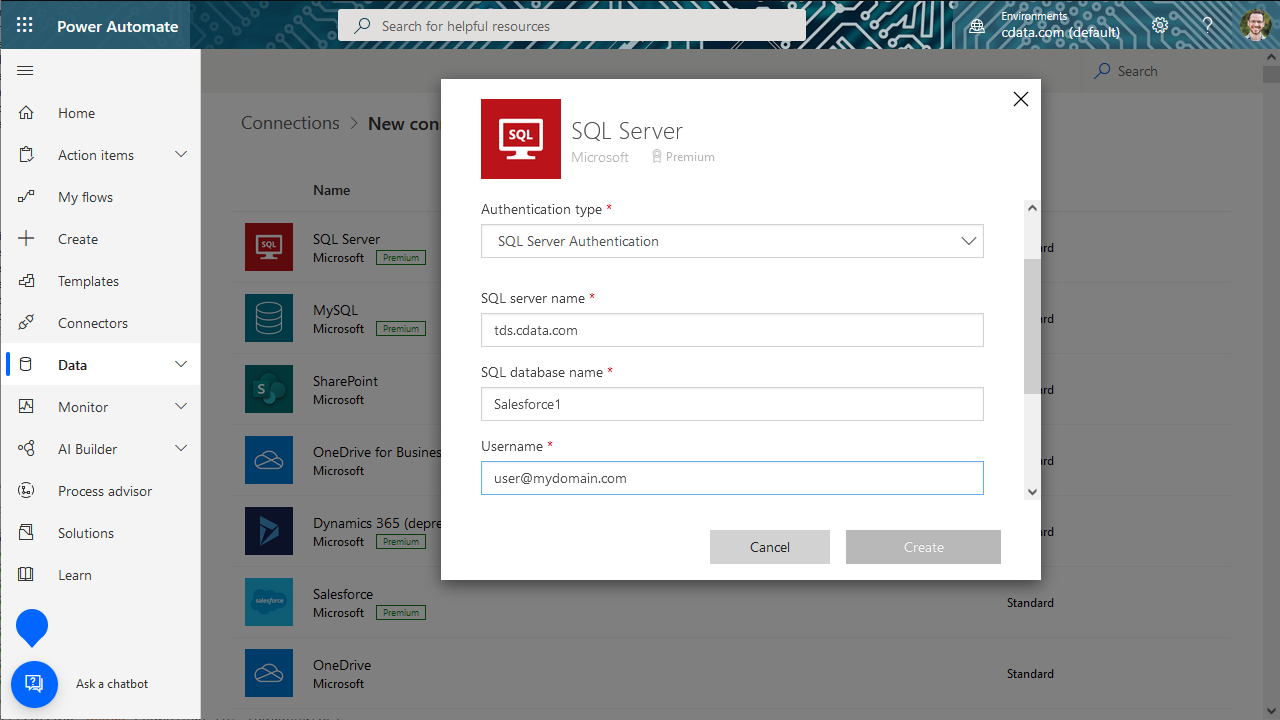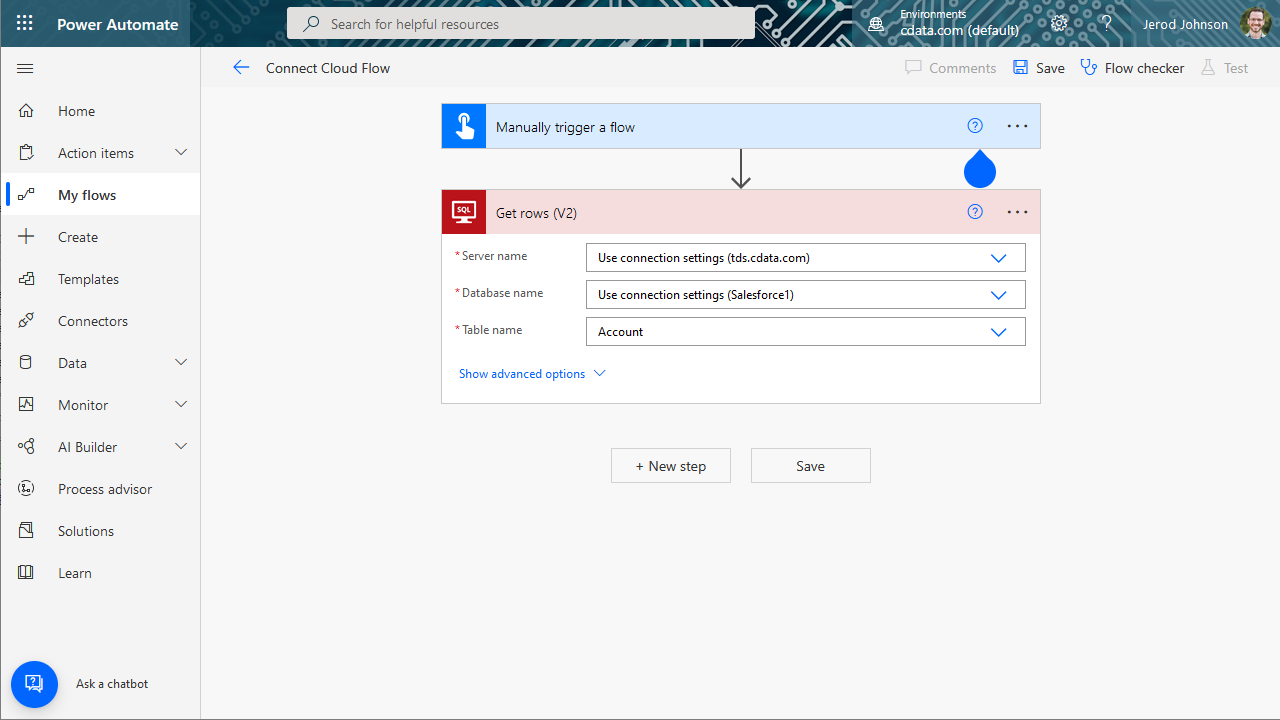Model Context Protocol (MCP) finally gives AI models a way to access the business data needed to make them really useful at work. CData MCP Servers have the depth and performance to make sure AI has access to all of the answers.
Try them now for free →Integrate NetSuite Data into Automated Tasks with Power Automate
Use CData Connect Cloud to connect to NetSuite data and integrate live NetSuite data into your Power Automate tasks.
Microsoft Power Automate is an online service that automates events (known as workflows) across the most common apps and services. When paired with CData Connect Cloud, you get instant, cloud-to-cloud access to NetSuite data for visualizations, dashboards, and more. This article shows how to connect to Connect Cloud from Power Automate and integrate live NetSuite data into your workflows and tasks.
CData Connect Cloud provides a pure SQL, cloud-to-cloud interface for NetSuite, allowing you to easily integrate with live NetSuite data in Power Automate — without replicating the data. CData Connect Cloud looks exactly like a SQL Server database to Power Automate and uses optimized data processing out of the box to push all supported SQL operations (filters, JOINs, etc) directly to NetSuite, leveraging server-side processing to quickly return NetSuite data.
About NetSuite Data Integration
CData provides the easiest way to access and integrate live data from Oracle NetSuite. Customers use CData connectivity to:
- Access all editions of NetSuite, including Standard, CRM, and OneWorld.
- Connect with all versions of the SuiteTalk API (SOAP-based) and SuiteQL, which functions like SQL, enabling easier data querying and manipulation.
- Access predefined and custom reports through support for Saved Searches.
- Securely authenticate with Token-based and OAuth 2.0, ensuring compatibility and security for all use cases.
- Use SQL stored procedures to perform functional actions like uploading or downloading files, attaching or detaching records or relationships, retrieving roles, getting extra table or column info, getting job results, and more.
Customers use CData solutions to access live NetSuite data from their preferred analytics tools, Power BI and Excel. They also use CData's solutions to integrate their NetSuite data into comprehensive databases and data warehouse using CData Sync directly or leveraging CData's compatibility with other applications like Azure Data Factory. CData also helps Oracle NetSuite customers easily write apps that can pull data from and push data to NetSuite, allowing organizations to integrate data from other sources with NetSuite.
For more information about our Oracle NetSuite solutions, read our blog: Drivers in Focus Part 2: Replicating and Consolidating ... NetSuite Accounting Data.
Getting Started
Configure NetSuite Connectivity for Power Automate
Connectivity to NetSuite from Power Automate is made possible through CData Connect Cloud. To work with NetSuite data from Power Automate, we start by creating and configuring a NetSuite connection.
- Log into Connect Cloud, click Connections and click Add Connection
![Adding a Connection]()
- Select "NetSuite" from the Add Connection panel
![Selecting a data source]()
-
Enter the necessary authentication properties to connect to NetSuite.
The User and Password properties, under the Authentication section, must be set to valid NetSuite user credentials. In addition, the AccountId must be set to the ID of a company account that can be used by the specified User. The RoleId can be optionally specified to log in the user with limited permissions.
See the "Getting Started" chapter of the help documentation for more information on connecting to NetSuite.
![Configuring a connection (Salesforce is shown)]()
- Click Create & Test
- Navigate to the Permissions tab in the Add NetSuite Connection page and update the User-based permissions.
![Updating permissions]()
Add a Personal Access Token
If you are connecting from a service, application, platform, or framework that does not support OAuth authentication, you can create a Personal Access Token (PAT) to use for authentication. Best practices would dictate that you create a separate PAT for each service, to maintain granularity of access.
- Click on your username at the top right of the Connect Cloud app and click User Profile.
- On the User Profile page, scroll down to the Personal Access Tokens section and click Create PAT.
- Give your PAT a name and click Create.
![Creating a new PAT]()
- The personal access token is only visible at creation, so be sure to copy it and store it securely for future use.
With the connection configured, you are ready to connect to NetSuite data from Power Automate.
Connecting to CData Connect Cloud
To use Connect Cloud to integrate NetSuite data into your Power Automate tasks, you need a new SQL Server connection:
- Log in to Power Automate
- Click Data -> Connections -> New connection
- Select SQL Server
![Creating a new SQL Server Connection]()
- In the connection wizard:
- Choose to connect directly
- Set SQL server name to tds.cdata.com
- Set SQL database name to the name of the NetSuite connection (e.g. NetSuite1)
- Set Username to a Connect Cloud user (e.g. user@mydomain.com)
- Set Password to the PAT for the above user
- Click Create
![Connecting to Connect Cloud]()
Integrating NetSuite Data into Power Automate Tasks
With the connection to Connect Cloud configured, you are ready to integrate live NetSuite data into your Power Automate tasks.
- Log in to Power Automate
- Click My flows -> New flow and choose to create the flow from blank or template
- Add (or configure) a SQL Server action (like Get rows) and configure the action to connect to your Connect Cloud connection
- Select a Table to work with (from the drop-down menu) and configure any advanced options (like filters, orders, etc)
![Getting NetSuite "Rows"]()
- Configure any actions to follow and test, then save the flow
SQL Access to NetSuite Data from Cloud Applications
Now you have a direct connection to live NetSuite data from Power Automate tasks. You can create more connections and workflows to drive business — all without replicating NetSuite data.
To get SQL data access to 100+ SaaS, Big Data, and NoSQL sources directly from your cloud applications, sign up for a free trial of CData Connect Cloud.
Related Power Automate Articles
This article walks through using CData Connect Cloud with Power Automate (Online). Check out our other articles for more ways to work with Power Automate Desktop:









